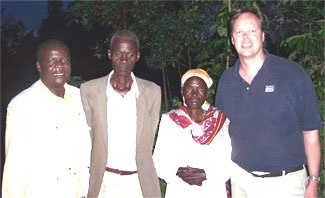|
|
People often ask me, “When you go off and do these missions, does any lasting good come from it?” Sadly, many miss out on knowing how to answer that question because their team only visits a locale once and then moves on to greener pastures. Through our fellowship, Subiaco Church in Perth, Western Australia, we have been returning to the same region of Africa, Bungoma, in Northwest Kenya for over ten years. In that time, we have witnessed twenty-three new church plants, an orphanage and school, and countless numbers of lives transformed. Sarah is one of those stories.
Sarah was a witch, making her one of the most powerful and influential persons in her community. Her mother was a witch as was her mother's mother. Young apprentice girls would seek her out when wanting to learn the secrets to her dark practices. Spells and sacred instruments had been passed down from generation to generation. About five years ago, we conducted a mission in her village. Typically, a stage and sound system is set up in the village centre. A number of people, both locals and visitors, present their story of how Christ has impacted their lives. On this occasion, I was called upon to give a challenge to embrace Jesus and receive the new life available through the cross and a commitment to follow him. After the presentation, the audience was asked to come forward by faith. A local pastor instructed the respondents and pointed to a large tree saying, “Next Sunday, we will begin a new church and we will meet right there. You are all welcome.”
Among those who responded was Sarah. Immediately it created a stir. Was this witch really serious about following Jesus? Indeed, three days later she agreed to a ceremonial burning of her sacred instruments. This entailed the destruction of all the magical items passed down to her as well as potions and forbidden plants. By doing this in her village, she was making a powerful statement about the superiority of Jesus over the powers of darkness. Some villagers, while being curious, were too frightened even to attend the burning. Pastors and key lay leaders from neighbouring villages were present and the singing, praise and prayer were a sight to behold.
After several years I returned to Bungoma on a follow-up tour. I wanted to encourage the fledgling churches that were started through these missions. As we walked up to this new African building, a number of women came to welcome us, holding a chicken dish and handmade bread. As we exchanged greetings, I recognised Sarah's face. “Are you still following Christ?” I asked with expectation. “Yes,” she replied as she covered her mouth, embarrassed by her poor English. Excited to see her again, I immediately asked that a photo be taken of the two of us.
A woman who once held sway over a community through fear was now humbling herself by waiting on others with food in hand.
Later, as the more formal program began, the new building was filled with villagers. Only years ago there was no believing witness in this community; today the facility is overflowing with men, women and children giving praise to the Lord. Many approach me to say they were a part of that original group who began meeting under a tree years ago. The pastor who was appointed to spearhead this initiative unfolded the story of the fellowship's progress. Land is always the most difficult acquisition in a case like this; however, someone came forward to donate the property at no cost to the church. Who would surrender such a costly possession that would have been in his or her family for generations? It was Sarah. She was asked to stand and speak in her own dialect. “I wanted to ensure that a living testimony to Jesus would exist in my village so that everyone could know the happiness that I have experienced,” she said. A woman who once held sway over a community through fear was now humbling herself by waiting on others with food in hand.
When people ask me, “Is there any lasting difference?” my reply is simply to show them the photo of Sarah and me.


